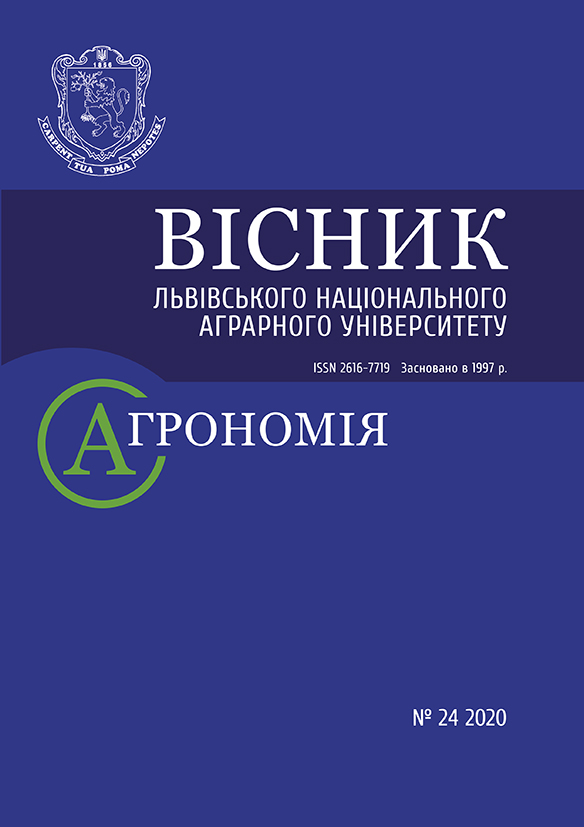Visnyk LNAU: Agronomy 2018 №22(2): 141-144
MILK PRODUCING ABILITY AND FATTY ACID COMPOSITION OF MILK LIPIDS UNDER APPLICATION OF “BYPASS” OIL ADDITIVES IN THE DIET OF COWS
Pavkovych S., Candidate of Agricultural Sciences
Lviv National Agrarian University
Vovk S., Doctor of Biological Sciences
Institute of Agriculture Carpathian region NAAS
Balkovskyi V., Candidate of Agricultural Sciences
Ohorodnyk N., Doctor of Veterinary Sciences
Ivankiv M., Candidate of Agricultural Sciences
Lviv National Agrarian University
Sirko Ya., Candidate of Agricultural Sciences
Institute of animal biology of NAAS
https://doi.org/10.31734/agronomy2018.02.141
Annotation
The article presents results of the research concerning the impact of feeding of lactating cows with linseed oil and calcium salts, produced on its base, on milk producing ability and fatty acid content of milk. It is determined that application of the additives of linseed oil in the diets of lactating cows reduced the daily average milk yield and the share of fat, protein and lactose in it. Consequently, it reduced output of the mentioned milk components in the experiment period.
Feeding of cows with calcium salts of fatty acids produced on its base, increased the daily average milk yield and the share of fat in it. However, the share of protein and lactose demonstrated some reduction. For the studied period, the share of obtained milk fat and lactose was larger than the control. The experiment also determined that the share of organic substance reduced in the milk of the second group cows, and in the third group cows the indicator was higher comparing to the control.
Measuring the fatty acid content of milk, it was determined that feeding of cows with fatty additives increased the level of C18 and reduced C14-16 fatty acids in the content of milk fat. Application of calcium salts of fatty acids, produced on the base of linseed oil, in the diet of cows reduces the share of myristic acid and increases the level of linoleic and linolenoic acids.
Application of the additives of calcium salts of fatty acids, produced on the base of linseed oil, in the diet of lactating cows increases milk fat in milk and rises the share of mono- and polyunsaturated fatty acids in the content of milk fat. Particularly, it reduces the level of C14-16 and increases the share of C18 acids in the content of milk fat.
Key words
lactatingcows, linseed oil, milk yield, milk composition
Full text
Link
- Vovk S. O., Pavkovych S. J. Protection lipids and fatty acids in feed rations cattle. News of agrarian sciences. 2016. No 4. P. 48–51.
- Drozd I. F. Fatty acid composition of oil flax seed in the conditions of the western region of Ukraine. Bulletin of the Institute of Grain Farming. 2011. No 40. P. 72–76.
- Vovk S. O., Snitynskyy V. V., Pavkovych S. J., Kruzhel B. B. Fat supplements in feeding animals and birds: monograph. Lviv: SPOLOM, 2011. 208 p.
- Kurko V. I. Gas chromatographic analysis of food products. Kyiv: Harvest, 1965. P. 65–69.
- Bartnikowska E., Kulasek G. Importance of unsaturated fatty acids in human and animal nutrition. Second Part. Med. wet. 1994. Vol. 50. P. 34–38.
- Brzóska F. Effect of fatty acid calcium salts from linseed oil on the yield and n-3 fatty acid content of milk and on blood plasma parameters of cows. J. Anim. Feed Sci. 2006. Vol. 15. P. 347–360. https://doi.org/10.22358/jafs/66906/2006
- Effect of oilseed type on milk fatty acid composition of individual cows, and also bulk tank milk fatty acid composition from commercial farms / K. E.Kliemet al. Animal. 2017. Vol. 11. Issue .2. P. 354–364.
- Replacement of saturated with unsaturated fats had no impact on vascular function but beneficial effects on lipid biomarkers, E-selectin, and blood pressure: results from the randomized, controlled dietary intervention and vascular function (DIVAS) study / К. Vafeiadou et al. Amer. J. Clin. Nutr. 2015. Vol. 102. P. 40–48.
- Sources of n-3 polyunsaturated fatty acids additional to fish oil for livestock diets – a review / D. I. Givens et al. Nutr. Abstr. Rev. 2000. Ser. B 70. P. 1–20.



